Motorola Xoom Review: The First Honeycomb Tablet Arrives
by Anand Lal Shimpi on February 23, 2011 11:57 PM ESTMultitasking on Android: Done Right
Android has had multitasking since the start. Fire up an app and it can continue to execute even after you’ve shifted focus to another app (or the home screen) until you run out of memory. Once you reach a certain threshold of memory usage Android will automatically unload the least recently used app from memory.

The iOS 4 Task Switcher
What Android hasn’t had since the start is a good way of switching between apps. On iOS you double tap the home button to bring up a list of apps in memory, which you can use as a task switcher. Windows Phone 7 currently relies on a very powerful back button to switch between recently used apps, and eventually will implement a webOS-like card system. Android however did it the simplest way possible: tap home and run what you want to run next (Update: as well as tap and hold on home to bring up a list of recently used apps).
Honeycomb builds upon this. The third fixed button on the lower left brings up a list of up to five of your previously run apps/tasks (tap n hold home is gone). Each item has a text label telling you what it is as well as a visual preview.
For the most part it’s actual apps that will appear in this list (e.g. Twitter, Browser, Talk, etc...) however settings pages can appear here as well.
Unfortunately the task list is limited to five items - you can’t scroll to reveal more. I feel like this is a pretty big limitation as I do find myself going back to the Apps launcher screen more than I’d like given the functionality here. There’s also no way to force quit apps from this list, which would’ve been another nice addition.
New Notifications & Widgets
Honeycomb offers you more options to switch between apps than just heading back to the home screen. There’s the new multitasking UI, but there’s also the new notification area. Instead of having to pull down a shade to reveal notifications they simply pop up in the lower right corner of the screen and remain as icons to the left of the clock. Tapping on any of the notification icons brings up the full notification and also lets you clear it. If you tap on the signal/battery strength indicators you’ll reveal a stacked list of all of the notifications. If you have more than 6 notifications the stack will grow a scroll bar to show more.
Tap once more, this time on the full notification, and you’ll fire up the associated app. The combination of the new notifications and the task switching UI means that switching between apps in Honeycomb is more like your desktop PC. It’s not quite perfect yet, but we’re getting there - and in my opinion it’s better than what’s currently available on the iPad.
Google seems sold on the use of widgets as a major feature of Android. Personally I feel like widgets are more of a placeholder until we get full blown application windows that we can toss around our tablet desktop. If you subscribe to that thought process then what Google has done with widgets in Honeycomb will make a lot of sense. In Gingerbread and prior version of Android, widgets were fairly constrained and two dimensional. You could display information within the widget but there was no depth and no concept of scrolling.
Take a look at the email widget from Honeycomb:
It’s basically a mini inbox viewer. You can scroll to view emails in your inbox or even tap the top of the widget to switch between viewing all emails and just those you haven’t read. You can’t read messages, delete or reply from within this widget, but tapping any email will open up the email app itself. As I said earlier, we’re just one step away from widgets becoming full blown apps that simply expand in place when we need them.
Honeycomb also provides some functionally decorative widgets, such as the picture frame which simply shows you a portion of one of your images. Tapping on the picture frame widget will open up the full sized photo it’s framing.
Stacks are also supported in Honeycomb widgets. Take the YouTube widget for example:

Here you get a stack of featured YouTube videos. The Books widget is also stacked, however it shows you covers of books you've loaded onto the Xoom. Tapping anything in a stack launches the associated app.
The Honeycomb Google search widget simultaneously generates web search queries as well as searches your local apps and contacts for your search string. There’s no Google Instant integration, but the UI is clean.
Adding widgets is as easy as hitting the + icon in the upper right of the screen. The default Honeycomb UI has five home screens - you can drag widgets and app shortcuts to any of them from the widget adder UI.
All of these widgets echo the same basic message in Honeycomb: giving you access to content and data in ways other than just going to the Apps launcher.
Apps Launcher
If the multitasking UI and the new notifications don’t get you to where you need to go, there’s still the old fashioned apps launcher. Located in the upper right of the screen (talk about turning Android on its head) tap the word Apps to reveal a more familiar looking grid layout of apps.
The apps are organized into horizontal pages instead of a vertical list. Google has also added a My apps tab to show just the apps that you’ve downloaded, not the apps that come as a part of Honeycomb.
I’d love to see a quick search field here so you could just start typing to find the app you’re looking for but perhaps we’ll see that in a future version of the OS.


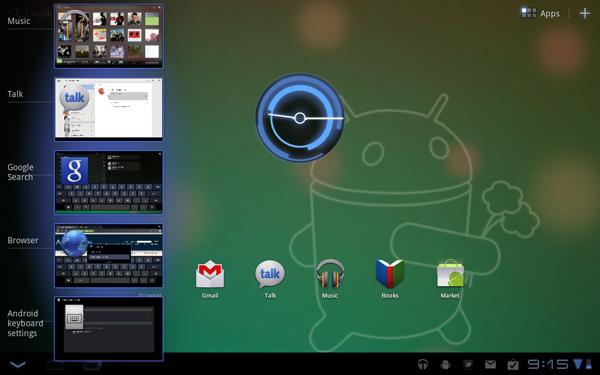
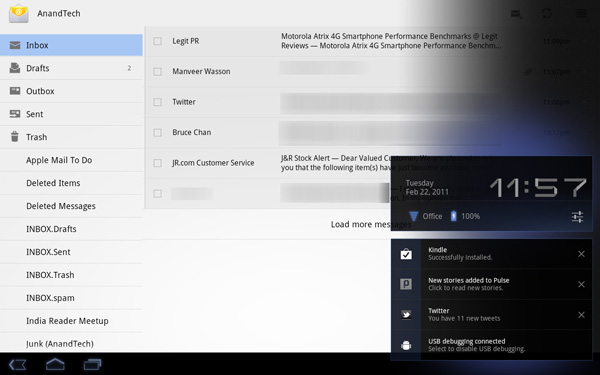
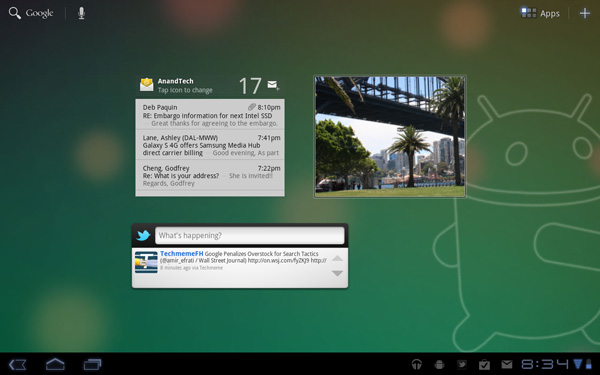
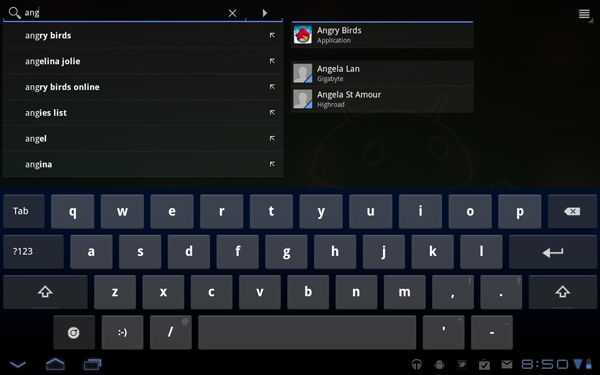
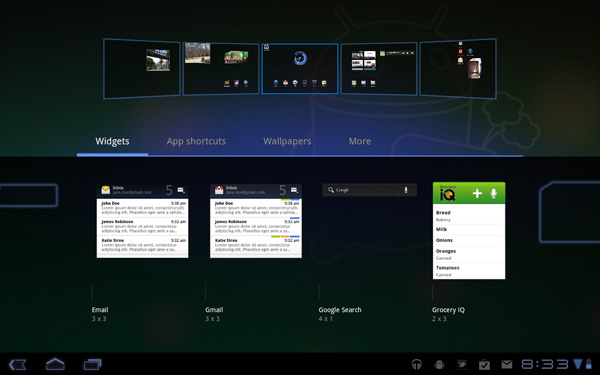
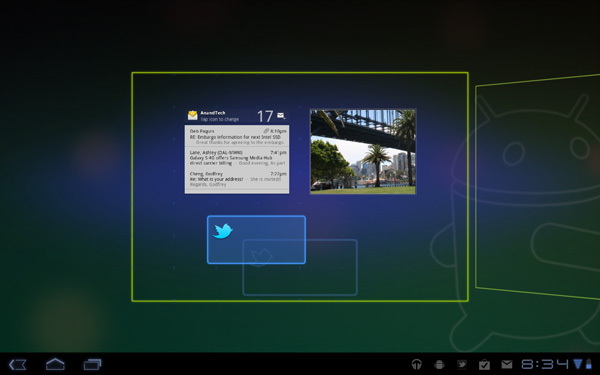
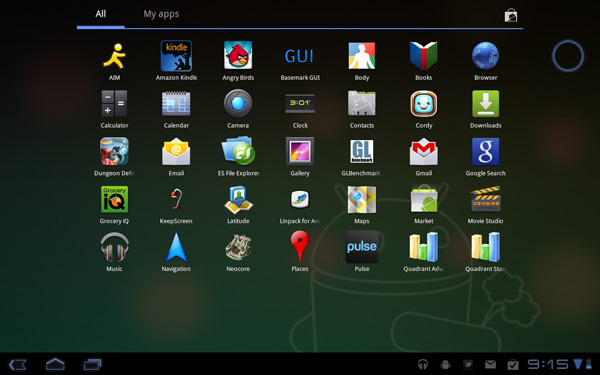
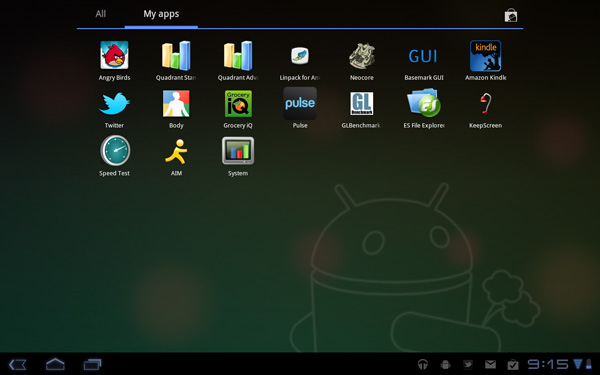








112 Comments
View All Comments
GotThumbs - Friday, March 18, 2011 - link
Motorola was just taking advantage of early adopters....Come March 27th. the 599.00 WIFI only version will be released. This directly competes with ipad pricing. :-) I'm getting one of those babies for sure. No apple 'force fed' products for me. I like making my own choices....onelin - Thursday, February 24, 2011 - link
Could you add some video playback battery life comparisons with the iPad? I am interested if that matches up similar to the web browsing.omidk - Thursday, February 24, 2011 - link
Does this support caldav or exchange?Its been pretty frustrating having to rely on vendor customizations for exchange support. If google would build in caldav I think a lot of people could run stock android.
TareX - Thursday, February 24, 2011 - link
The browser (provided that it gets flash) is what should make people choose this as opposed to the iPad.Who needs money-draining apps when you have a PC-like browsing experience?
mlambert890 - Thursday, February 24, 2011 - link
I really feel this is academic and minutiae to justify a predetermined position.I use the iPad every day. I am not a "fan" of anything and actually spent my entire 30s working at Microsoft - a full decade.
I can honestly say, using the iPad *every day* that there is ever a time I am cursing the browser and wishing I had a "real PC experience". Occasionally I miss flash, but the world is moving towards HTML5 anyway and rightly so.
If, on the other hand, your goal is to replicate a desktop on a tablet, and you will barely use it or use it as a complete notebook replacement for outlier cases, then you might want some of what Anand covered here.
I submit that 90% of the market for these devices do not fit in that category at all.
All odf the same BS was said about Netbooks. I remember this chatter *inside* MSFT as well. Total disconnect from what the real mass market growth space wants and needs. This is why apple continues to do so well. Apple directly serves "the sheep", as the "hardcore" like to label regular folks. Thing is... The "sheep" spend 90% of the money.
As for apps, I think ive spent maybe a total of $50 on iPad software, so your implication that somehow a fortune must be spent to supplement Safari with apps is ridiculous. Try being objective and lose any brand bias or personal use case focus and you will see this differently.
Android on phones did well by copying Apple and then spreading cheap devices across lots of carriers. Period, the end. Any side effect that appeals to geeks ("openness", Linux base, whatever) is there in spite of that success, it is not a cause.
If Google attempts to create a desktop UX on a tablet, I am almost certain they will fail to capture anything but an extremist niche.
bplewis24 - Thursday, February 24, 2011 - link
I really feel this is academic and minutiae to justify a predetermined position.Oh, and that's me responding to your post, not a quote.
And you really just come off as an idiot or fanboy by saying that Android did well by "copying Apple and .. spreading cheap devices across a lot of carriers." That is one of the dumbest things I've ever read online that wasn't uttered by Glenn Beck.
As far as your last sentence, you keep being certain of that, just as much as you are probably certain that the rest of your post doesn't come off as irrational drivel.
Brandon
ccrobopid - Saturday, February 26, 2011 - link
> And you really just come off as an idiot or fanboy by saying that Android did> well by "copying Apple and ..
He maybe came off as an idiot (I don't think so) but I think he's right. I see people with android phones trying to use them as iPhones and ignoring the rest of the features.
I, as a tech savvy user feel ignored by tech manufacturers. It's clear to me that my tastes are not those of the majority. I have to buy 16:9 laptops for programming, if I want a tablet with a good screen I have to give up having a file system or watching content in the formats I want, etc., etc.
I wonder what would happen if we, as the workforce that make all this products for the masses possible will get on strike and refuse to work until products that appeal to us are made.
We are a minority, but I feel unfair to be ignored like any other minority by the people we work for
:D :D
bplewis24 - Tuesday, March 1, 2011 - link
While you are correct in saying that the majority of the people who own Android phones likely don't utilize all of it's features and use them as iPhone clones, so to speak, that doesn't mean that Google has copied Apple in it's OS vision.Anand goes into detail in the first page about how Google has decided to differentiate itself with Android, and I think most tech-savvy people realize that there are some very key, significant differences with the two software platforms. Stock Android from the G1 was vastly different from iPhoneOS of that day.
While both have added significant features and ultimately will continue to copy each other's advancement or try to best it, they still go about it in different ways. For example, iOS continues to try to catch up in the multi-tasking arena, but they still do so differently.
Brandon
spinron - Thursday, February 24, 2011 - link
I have a Pandaboard here (a TI OMAP4 reference platform) and just for fun I loaded it with XBMC and configured it with the full suite of TI's proprietary drivers (DSP, IVA, PowerSGX, etc). It played pretty much anything I threw at it, including some very high bit rate AVC in MKV containers that put quite a strain on dedicated Sigma silicon. My guess is that the Tegra2 has comparable video decoding power, so whether Xoom-like tablets will become universal video players will essentially boil down to software availability. So strictly speaking, Kal-el-like hardware is probably not going to be required just for that purpose.Great review! It's certainly much more objective than most of the others. Walt Mossberg's review on ATD was particularly funny (and simultaneously sad) to watch.
Your mobile SB review looked so convincing it looks like my next major buy is probably going to be a new SB i7 MBP. Coupling fast I/O with a laptop seems like a real game changer, most certainly in Apple's world. Can't wait for a review...
halcyon - Thursday, February 24, 2011 - link
Finally a tab that almost manages the 10hr mark on benchmarks.That means that in true real-world usage it might really last the 8hrs, even after the battery has been through a few recharge cycles.
The screen is bit of a let-down as you state.
Ah well, here's hoping Samsung did the right thing on their tablet.
The wait continues.